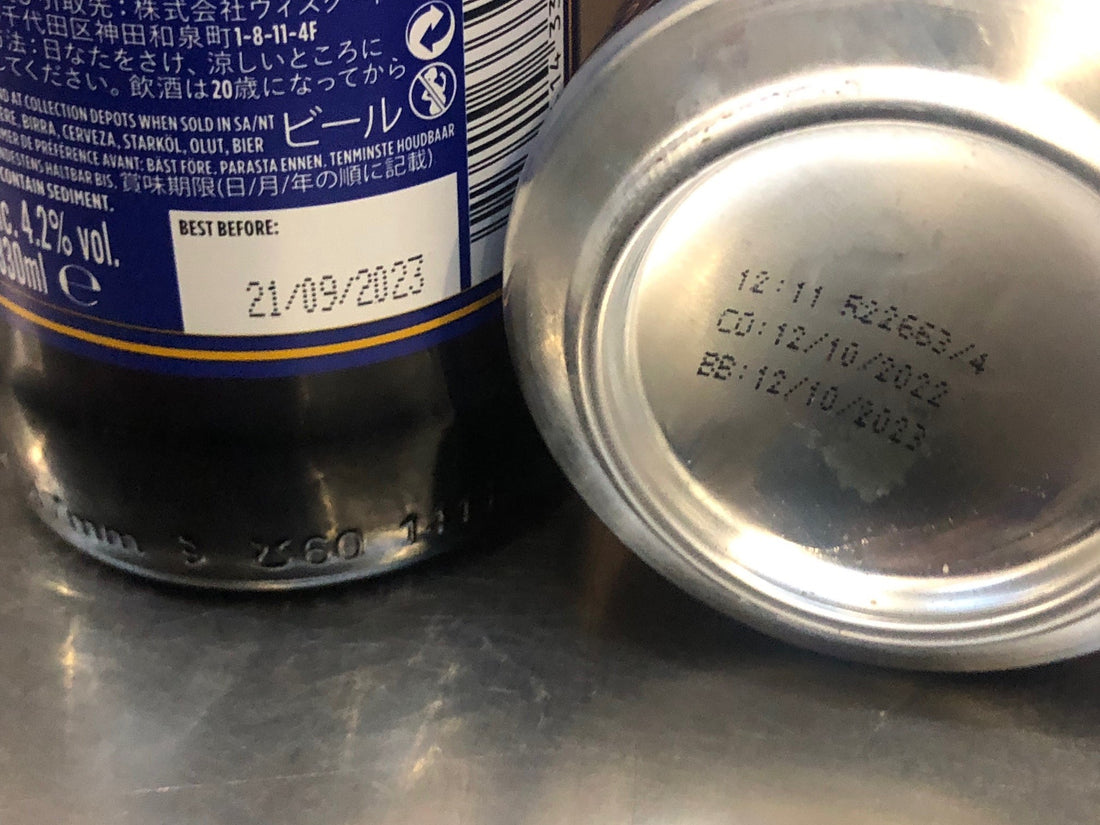
Can you drink out of date beer?
Share
‘Best Before Date’ (BBD) and ‘Use By Date’ (UBD) are a big contention here at Thornbridge! Production will always argue for shorter and shorter dates on beer as they want the beer to be drunk as fresh as possible (with a few exceptions such as Barrel Aged Stouts), whereas Sales will say it is a struggle to sell our minimum run of 15,000 x 330ml cans with a short date.
We have an unwritten rule that ‘hazy’ beers (beer that has not been filtered or centrifuged thus leaving hop matter and live yeast) gets packaged with 6 months BBD from packaging date. ‘Bright’ beers (beer that has been filtered and/or centrifuged to remove hop matter and yeast) gets 12 months and ‘big and dark’ beers (beers that are generally in double digit abv and do not rely mostly on hops for aroma and flavour) get 18 – 60 months depending on the abv, style, barrel ageing etc.
The reason behind these guidelines is that hazy beer is by all accounts, an unstable product. The ‘haze’ in hazy beer is created when specific proteins from malt and adjuncts, such as flaked wheat, interact with polyphenols from hops to form complexes which, over time, precipitate out of solution. Most importantly, hazy beers often rely on very expensive hops for aroma and flavour and these hops are at their very best when fresh. For each week or month that passes from packaging, the beer is essentially deteriorating in ‘zing’ from the day it was packaged. This deterioration (the ‘staling process’) is accelerated when the packaging process is not satisfactory in terms of dissolved oxygen (the amount of O2 that is allowed to enter the beer at packaging point). This is why we have invested so heavily in our packaging lines and in our laboratory - we simply don’t allow beer to leave the brewery if the dissolved oxygen is out of spec or for any other reason that is going to affect the quality of the beer. Our aim is to ensure the beer tastes as great as possible for as long as possible.
That being said, we had an incident this week where, due to a mistake in stock rotation, we sent out some cans of hazy beer that had just passed its 6 month BBD. We found some of the offending cans, tried them and came to the conclusion that they tasted virtually identical to the same beer that was packaged last week. This is obviously re-assuring! However, I can’t see me being able to change the mind of Rob Lovatt (Production Director / Head Brewer) to put 12 months on said beer and rightly so; we need to maintain our standards and ensure our beer is drunk at a time where the flavour and aroma resembles exactly how it was intended on the day it was packaged, rather than just trying to send beer to far flung parts of the world with extended dates that do nothing for our beer or brand.
Does beer go off and can you drink out of date beer or lager?
Some supermarkets have recently started adopting a strategy of not putting a BBD or UBD on fresh fruit and vegetables to try and help alleviate the millions of tonnes of fresh produce we throw away each year. We all know somebody that looks at a BBD or UBD that has expired and throws the offending item in the bin without even looking at it to make a judgement call on whether it can be consumed. This is an excellent initiative and is a guideline to how out of date beer should be imbibed. Does it smell like beer? Does it taste like beer? If so, it’s probably perfectly fine to drink even if it’s not as incredible as the day it left the brewery.
How to keep beer fresh as possible
As mentioned, we take great care to package your beer fresh and with as little oxygen as possible so that oxidation won’t be a problem with your Thornbridge beer. We have also starting using the Cyclops method on our beer descriptors advising of the ideal temperature at which to serve your beer, but wherever possible, beer should be stored cold with an ideal storage temperature of 2-7 Celsius. Generally, the warmer the beer, the faster the hop flavour and aroma will fade and ‘off’ flavours will develop.


Within our courier system, our aim is to get the beer to you as quickly as possible. Many beers can be stored at ‘ambient’ temperature for short periods of the time and the flavour impact will be minimal. However, if the weeks turn into months then more beer drinkers will be able to discern the changes in flavour
Beer should never be stored above room temperature, so do not keep beer in the boot of your car on a hot day. However, simply allowing cold beer to warm up to room temperature once or twice will not do any significant harm to the beer as long as its returned to ideal (2-7 degrees Celsius) temperatures.
Therefore, the general rule of thumb for beer storage is ‘store beer cold’ or drink it!!!
Try our Fridge Filler mixed beer case
Can I freeze beer?
Brewing an ‘Eisbock’ style beer is the only time that beer and freezing go together!
Beer doesn't freeze well for a number of reasons so its definitely not a way of storing your beer for longer. If the increased volume and pressure from frozen beer doesn't explode the packaging then you are probably in for a disappointing experience even if you let the beer thoroughly thaw out.
However, we have all been there - friends are coming round, the beer needs a quick chill so the beer is flash chilled in the freezer. But if you do need to flash chill then the best way to chill beer quickly is to put the bottles and cans in a bucket of salted iced water. Salt lowers water’s freezing point, so the ice water surrounding your beer is actually colder than zero degrees so your beer chills faster, with no risk of it being forgotten and freezing overnight.
Packaging to keep beer fresh
Beer has an unusual sensitivity to light that can alter the aroma and flavour of beer giving a distinctly unpleasant character. This process is known as ‘lightstruck’ or ‘skunked’ and occurs when beer is exposed to specific wavelengths of light found in natural sunlight and other forms of synthetic lighting. So if a beer is sitting in a shop window with sun shining on it then the beer will be ruined in a matter of days. Similarly, never buy clear bottles of beer that have been sat on a supermarket shelf exposed to bright strip lights, beer bottles are traditionally brown for a very good reason – to prevent them being lightstruck,. We use dark brown bottles which provides excellent protection as this blocks 98% of the damaging wavelengths of light. Incidentally, green bottles only prevent 20% so provide next to no protection and clear bottles block 0%.


1 comment
Really useful article. Most of my very large stock of beers are stored in our garage which remains very cold, especially during the winter months. Sometimes i come across a beer – or two – whose BBD has long since gone and yet it tastes pretty OK. Just occasionally I need to throw the beer away as it’s lost any zing, etc.